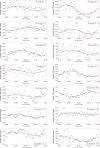Serum Levels of Human MIC-1/GDF15 Vary in a Diurnal Pattern, Do Not Display a Profile Suggestive of a Satiety Factor and Are Related to BMI
- PMID: 26207898
- PMCID: PMC4514813
- DOI: 10.1371/journal.pone.0133362
Serum Levels of Human MIC-1/GDF15 Vary in a Diurnal Pattern, Do Not Display a Profile Suggestive of a Satiety Factor and Are Related to BMI
Abstract
The TGF-b superfamily cytokine MIC-1/GDF15 circulates in the blood of healthy humans. Its levels rise substantially in cancer and other diseases and this may sometimes lead to development of an anorexia/cachexia syndrome. This is mediated by a direct action of MIC-1/GDF15 on feeding centres in the hypothalamus and brainstem. More recent studies in germline gene deleted mice also suggest that this cytokine may play a role in physiological regulation of energy homeostasis. To further characterize the role of MIC-1/GDF15 in physiological regulation of energy homeostasis in man, we have examined diurnal and food associated variation in serum levels and whether variation in circulating levels relate to BMI in human monozygotic twin pairs. We found that the within twin pair differences in serum MIC-1/GDF15 levels were significantly correlated with within twin pair differences in BMI, suggesting a role for MIC-1/GDF15 in the regulation of energy balance in man. MIC-1/GDF15 serum levels altered slightly in response to a meal, but comparison with variation its serum levels over a 24 hour period suggested that these changes are likely to be due to bimodal diurnal variation which can alter serum MIC-1/GDF15 levels by about plus or minus 10% from the mesor. The lack of a rapid and substantial postprandial increase in MIC-1/GDF15 serum levels suggests that MIC1/GDF15 is unlikely to act as a satiety factor. Taken together, our findings suggest that MIC-1/GDF15 may be a physiological regulator of energy homeostasis in man, most probably due to actions on long-term regulation of energy homeostasis.
Conflict of interest statement
Figures




References
-
- Zac-Varghese S, Tan T, Bloom SR. Hormonal interactions between gut and brain. Discov Med. 2010;10(55):543–52. Epub 2010/12/30. . - PubMed
Publication types
MeSH terms
Substances
Associated data
LinkOut - more resources
Full Text Sources
Other Literature Sources

